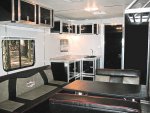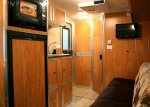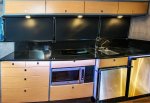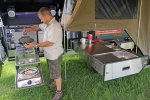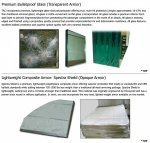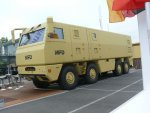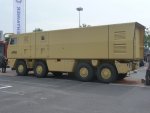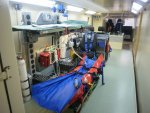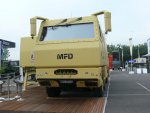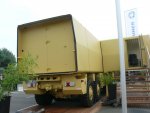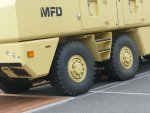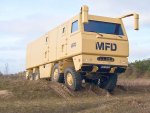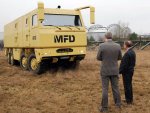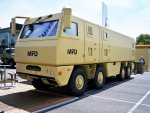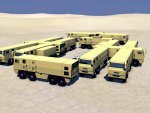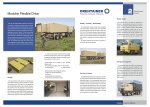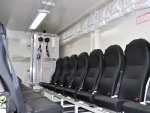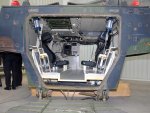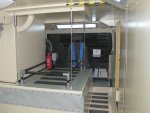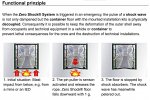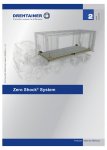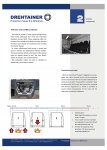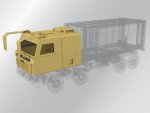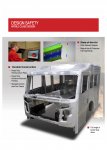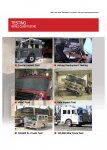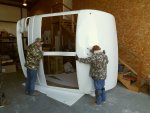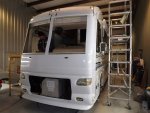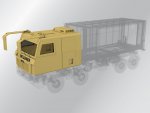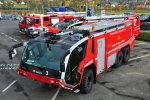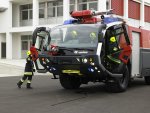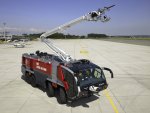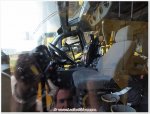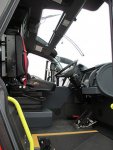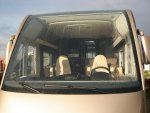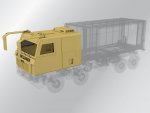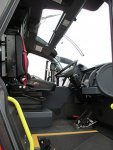..
Hi
Libransser,
safas,
Libransser, fantastic leads for Tesla!! I didn't know much about Tesla; now I know much more.
The energy density of Tesla's batteries really struck me. The last article you referenced stated 233 Wh/kg, which is quite astonishing, even better than the 156 W/kg that
safas just quoted. Suppose for the sake of mathematical simplicity that circa 2018 the energy density of Tesla batteries will be at least 250 Wh/kg, which means 4 kg per KW. A 200 KW battery pack would then weigh just 800 kg!! Which might tempt one to have the TerraLiner carry 300 KW of batteries weighing 1200 kg, for even longer noise-free glamping.....:ylsmoke:
.. I also liked reading about how Tesla's batteries are fast discharge/fast charge, because that will be important if the TerraLiner needs to suddenly rely on a big boost from the battery pack when driving up steep 6, 7, o 8 % mountain roads, inclines that
do exist, and that do exist on 4-lane highways where trucks can legally drive 120 kph....
I finally finished the posting series with the power calculations -- see posts #2127 - #2129 at
http://www.expeditionportal.com/for...w-6x6-Hybrid-Drivetrain?p=1974110#post1974110 and following.
safas, you may want to take a look at those posts, because in the final ones I took your advice, and got a bit less "conservative" with the basic assumptions, like the drag co-efficient (I am now assuming 0.41, the drag coefficient of the MAN SkyLiner), the frontal area (9.7 square meters, an oft-quoted, standard figure for large 4 m high x 2.5 wide trucks), and air-desnity (1.26, which is the density of air at sea level at 6 degrees Celsius). The power figures that I then get for the TerraLiner become very different.
Before, using
Iain's very conservative assumptions, for the TerraLiner to sustain a given speed on flat terrain without a headwind, I got:
[TABLE="class: outer_border, width: 200"]
[TR]
[TD]90 kph[/TD]
[TD]182.3 KW[/TD]
[/TR]
[TR]
[TD]100 kph[/TD]
[TD]227.4 KW[/TD]
[/TR]
[TR]
[TD]110 kph[/TD]
[TD]280.4 KW[/TD]
[/TR]
[TR]
[TD]120 kph[/TD]
[TD]341.8 KW[/TD]
[/TR]
[TR]
[TD]130 kph[/TD]
[TD]412.8 KW[/TD]
[/TR]
[/TABLE]
Whereas using more realistic assumptions that posit good TerraLiner aerodynamic design, more realistic air pressure, and 9.7 square meters of frontal area, I get:
[TABLE="class: outer_border, width: 200"]
[TR]
[TD]90 kph[/TD]
[TD]130.6 KW[/TD]
[/TR]
[TR]
[TD]100 kph[/TD]
[TD]156.6 KW[/TD]
[/TR]
[TR]
[TD]110 kph[/TD]
[TD]186.0 KW[/TD]
[/TR]
[TR]
[TD]120 kph[/TD]
[TD]219.4 KW[/TD]
[/TR]
[TR]
[TD]130 kph[/TD]
[TD]257.0 KW[/TD]
[/TR]
[/TABLE]
At 130 kph there's a
huge difference: roughly 150 KW. And even at 90 kph there's a difference of 50 KW. This matters, because the size of the primary generator needs to be set to handle most "normal" driving situations, including driving through flat or hilly country where 120 kph is the legal limit, and there's a 20 or 30 kph headwind.
Yes, yes, I know that in some countries like Germany 90 kph is the legal limit for trucks and 100 kph is the legal limit for buses. But Germany is not the world -- no country is -- and as already shown earlier in the thread, legal speed limits vary widely across the planet, even for trucks and buses. Canada and the United States allow 120 kph in some states and provinces, Australia allows 110 kph outside built-up areas, Pakistan and Romania the same, and some countries report variable figures such as 100 - 140 kph (UAE) or 60 - 120 kph (Venezuela) -- see
https://en.wikipedia.org/wiki/Speed_limits_by_country .
Regenerative braking and power boosts from the batteries will take care of the ups-and-downs of driving through low-lying hills, so the figures for travel on a flat plane are the most important. That's why I now think that the TerraLiner will probably need a primary generator that can produce 300 KW, or 400 HP, which means that the diesel ICE that powers it probably needs to be roughly 450 HP. That's still much smaller than the standard engines that are now being installed in premium 45-foot Class A motorhomes, for instance a Cummins 600 HP in Newell motorhomes, or the equivalent Volvo engine in Prevost-based motorhomes (because Prevost is owned by Volvo) -- see
http://www.newellcoach.com/features/specifications/ ,
http://www.newellcoach.com/wp-content/uploads/2014/06/NewellNews_Vol34Iss1.pdf ,
http://www.volvotrucks.com/TRUCKS/NA/EN-US/PRODUCTS/Pages/trucklanding.aspx ,
http://www.volvotrucks.com/trucks/na/en-us/products/powertrain/Pages/powertrain.aspx ,
http://www.volvotrucks.com/SiteCollectionDocuments/VTNA_Tree/ILF/Products/D13/D13 Family.pdf , and
http://www.volvotrucks.com/SiteCollectionDocuments/VTNA_Tree/ILF/Products/D16/D16 Family.pdf .
Here I should note, however, that even if the TerraLiner were driving at 120 kph with a 30 kph headwind for 5 hours, and consuming roughly 300 KW per hour, if the generator were rated for 280 KW, then the battery pack would be drawn down only 100 KW (20 KW X 5). So it might be possible, given the percentage likelihood of various driving scenarios, that a generator somewhere
between 260 and 300 KW would be more appropriate. Only a truck engineer who has experience designing for global markets would be able to guess the ideal "sweet spot" size for the primary generator, given a certain size of battery pack. All that I've done so far is suggest some of the scenarios that need to be taken into account, and give rough ballpark estimates of the power requirements.
For instance, check out my calculations for ascending the final 13 km of the Eisenhower pass, a 7 % grade where 120 kph is legal. It's a 4-lane highway, so 120 kph would be possible for a TerraLiner that had sufficient power: slow vehicles on the right, and vehicles that can handle the slope at high speed on the left -- post #2127 at
http://www.expeditionportal.com/for...w-6x6-Hybrid-Drivetrain?p=1974110#post1974110. I was still using
Iain's more conservative assumptions, and assuming a 200 KW primary generator combined with the Pratt & Whitney APS 5000 turboshaft APU producing 450 KW. But even the combined power of the two generators -- 650 KW -- was not enough to climb this slope at 120 kph with a 20 kph headwind. An additional 60 - 70 KW boost from the battery pack seemed necessary. I need to redo those calculations with newer, more realistic assumptions regarding the drag coefficient, air density at 3000 m, etc., and assuming a 300 KW primary generator instead.
safas: Here once again I really want to thank you for encouraging me to take another look at turbines. Yes, I know that installing a Boeing Dreamliner APU might seem excessive and slightly "science-fiction", but Ian Wright at Wrightspeed is into turbines, and I could imagine him loving the idea. Again, the turboshaft APU"s primary purpose would be to serve as a massive "power booster" so that the TerraLiner will be able to ascend long, steep inclines without a problem, like the 3 % sustained slope from
Dolalghat in Nepal to the
Tong La Pass in Tibet, a continuous ascent that's 151 km long; or ascend short, sharp, very steep slopes (6 - 8 %) that can be found on various 4-lane highways. See posts #2124 onwards, from section #38 onwards, at
http://www.expeditionportal.com/for...w-6x6-Hybrid-Drivetrain?p=1974106#post1974106 .
Apart from such turboshaft-boosted scenarios, the TerraLiner should prove quite fuel-efficient at "normal" highway driving speeds (55 - 65 mph), when powered by just a 300 KW generator -- and hence, probably a 450 HP ICE -- and with massive regenerative braking. "Quite fuel efficient" at least in comparison to the average large Class A motorhome. Large, 40 - 45 foot Class A motorhome typically get 6- 8 miles per gallon, so I think the target for the TerraLiner should be 10 mpg in "normal" driving -- see post #2129, section 49, at
http://www.expeditionportal.com/for...w-6x6-Hybrid-Drivetrain?p=1974540#post1974540 . If the TerraLiner were equipped with a 1500 liter diesel tank (i.e. 396 US gallons, the legal limit), then at 10 mpg it could drive 3,960 miles without refueling.....:sombrero:
,,,We'll see.
Again, streamlining and reducing the drag coefficient is paramount, and
Libransser, it was interesting to read that Tesla is now fitting Titanium plates to the bottoms of its roadsters, to prevent the possibility of a battery fire in a crash -- see
http://www.nytimes.com/2014/04/10/a...olution-to-preventing-model-s-fires.html?_r=0 ,
http://www.treehugger.com/cars/tesl...ld-and-aluminum-deflector-plates-model-s.html , and
https://www.teslamotors.com/blog/te...-shield-and-aluminum-deflector-plates-model-s :
It seems that the TerraLiner should do likewise, turning the entire underbody into one enormous "skid plate", as you suggested a while back.
But otherwise, Titanium will not be a realistic building material for most of the TerraLiner, as I will explain in the next few sections.
************************************************
CONTINUED IN NEXT POST.
.


